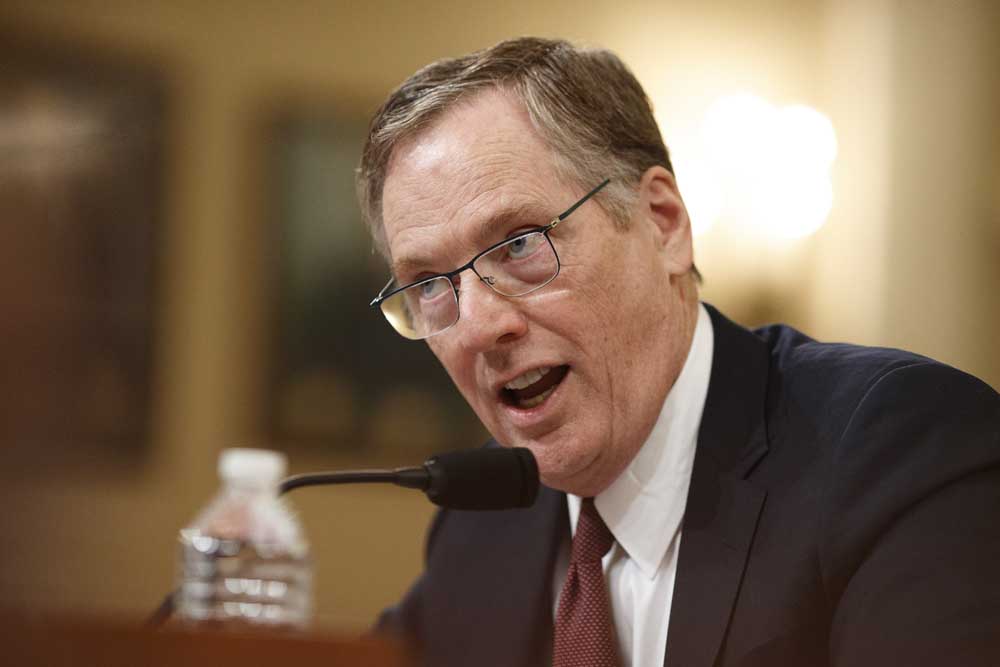Negotiator aims to reset U.S.-China relationship for Trump
Published 12:00 am Wednesday, January 2, 2019

- Robert Lighthizer, the U.S. trade representative, appears before the House Ways and Means Committee in Washington on March 21. (Tom Brenner/The New York Times)
WASHINGTON — In the middle of his crowded dinner in Buenos Aires, Argentina, with President Xi Jinping of China, President Donald Trump leaned across the table, pointed to Robert Lighthizer, the U.S. trade representative whose skepticism of China runs deep, and declared, “That’s my negotiator!” He then turned to Peter Navarro, his even more hawkish trade adviser, adding, “And that’s my tough guy!” according to aides with knowledge of the exchange.
Now, with talks between China and the United States set to begin this week in Beijing, Lighthizer, aided by Navarro, faces the assignment of a lifetime: redefining the trade relationship between the world’s two largest economies by Trump’s March 2 deadline in a way that tilts the balance of power toward the U.S. Their approach will have significant ramifications for American companies, workers and consumers whose fortunes are increasingly tied to China.
First, however, Lighthizer will need to keep the president from wavering in the face of faltering financial markets, which have suffered their steepest annual decline since 2008. Despite his declaration that trade wars are “easy to win” and his recent boast that he is a “Tariff Man,” Trump is increasingly anxious to reach a deal that will help calm the markets.
Trump has repeatedly told his advisers that Xi is someone with whom he can cut a big deal, according to people who have spoken with the president. On Saturday, Trump called Xi to discuss the status of talks, tweeting afterward that good progress was being made. “Deal is moving along very well,” Trump said.
The administration has tried to force China to change its ways with stiff tariffs on $250 billion worth of Chinese products, restrictions on Chinese investment in the United States and threats of additional levies on another $267 billion worth of goods. China has responded with its own tit-for-tat tariffs on U.S. goods. But over a steak dinner during the Group of 20 meeting in Argentina, Xi and Trump agreed to a 90-day truce and to work toward an agreement Trump said could lead to “one of the largest deals ever made.”
“It’s not some subtle shift; Trump has flipped since September,” said Derek Scissors, who studies China’s economy for the American Enterprise Institute. “He went from saying how he was going to slap tariffs on everything to all this talk about making the greatest deal ever.”
Lighthizer — whose top deputy will meet with Chinese officials this week before more high-level talks in February — has played down any differences with Trump and views his role as ultimately executing the directive of his boss. But the trade representative, who declined to be interviewed, has told friends and associates he is intent on preventing the president from being talked into accepting “empty promises” like temporary increases in soybean or beef purchases.
Lighthizer is pushing for substantive changes, such as forcing China to end its practice of requiring American companies to hand over valuable technology as a condition of doing business there. But after 40 years of dealing with China and watching it dangle promises that do not materialize, Lighthizer remains deeply skeptical of Beijing and has warned Trump the United States may need to exert more pressure through additional tariffs in order to win true concessions.
Trump’s pick of Lighthizer initially spooked markets, which viewed the China skeptic’s appointment as an ominous sign. It also annoyed Chinese officials, who had been talking with Treasury Secretary Steven Mnuchin, a more moderate voice and the primary point of contact for Liu He, China’s top trade negotiator.
Lighthizer has since worked to increase his own face time with Trump. He has told Trump the United States has never had more leverage to extract structural reforms on intellectual property, forced transfer of technology from American companies and cybercrime. But while Trump has jumped at the chance to claim victory in changing China’s ways, experts say what Lighthizer is demanding would require significant shifts in how Beijing’s central government and its manufacturing sector coordinate their activities, and that might simply not be possible in the short term.
Those who know Lighthizer say he will try to force concessions through a combination of pressure tactics, like tariffs, and public condemnation. Lighthizer, who described his own negotiating style as “knowing where the leverage is” during a 1984 interview, typically presents few specific demands during initial talks while publicly bashing efforts by the other side.
He used that approach during recent talks with Canada and Mexico to revise the North American Free Trade Agreement, criticizing foreign counterparts as intransigent and characterizing complaints by U.S. businesses as pure greed.
He does not always get his way. The president ignored Lighthizer’s advice in early December when he announced he intended to begin the six-month process of withdrawing the United States from NAFTA to pressure House Democrats into passing the new U.S.-Mexico-Canada Agreement. That threat undermined months of quiet negotiations between Lighthizer, labor groups and Democrats to try to win their support for the new trade deal. Trump has yet to follow through on his threat, and Lighthizer continues trying to work with Democrats to get the new trade deal approved.
“Bob is trying to provide stability and focus in a completely chaotic environment,” said Sen. Sherrod Brown, D-Ohio. “I can’t speak for Bob, but I am certain he is frustrated. How could you not be frustrated as the U.S. trade representative for a president who knows what his gut thinks but hasn’t put much of his brains into trade?”






